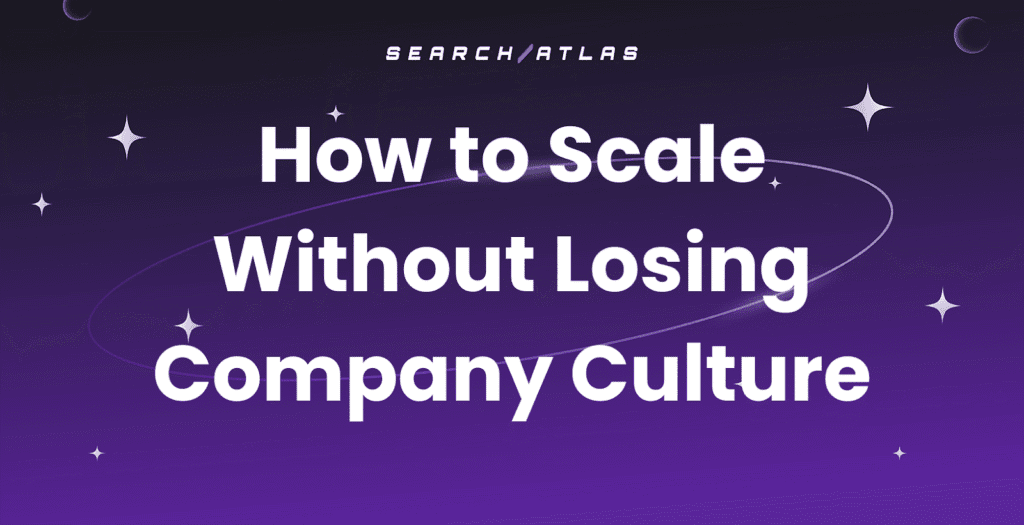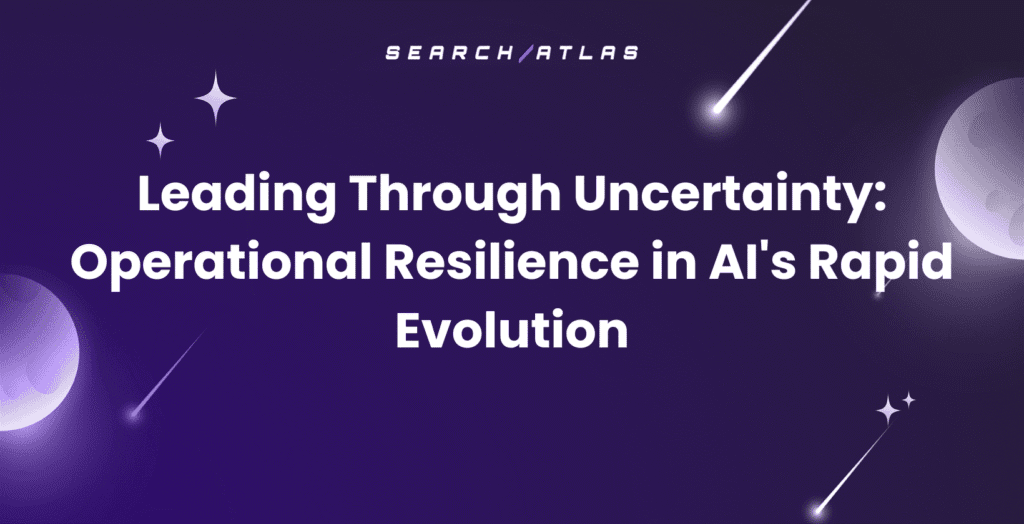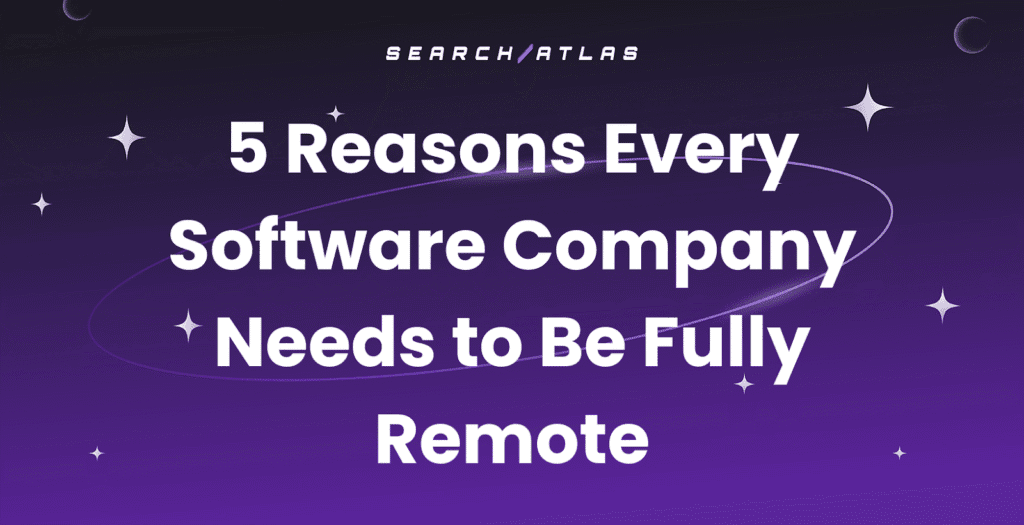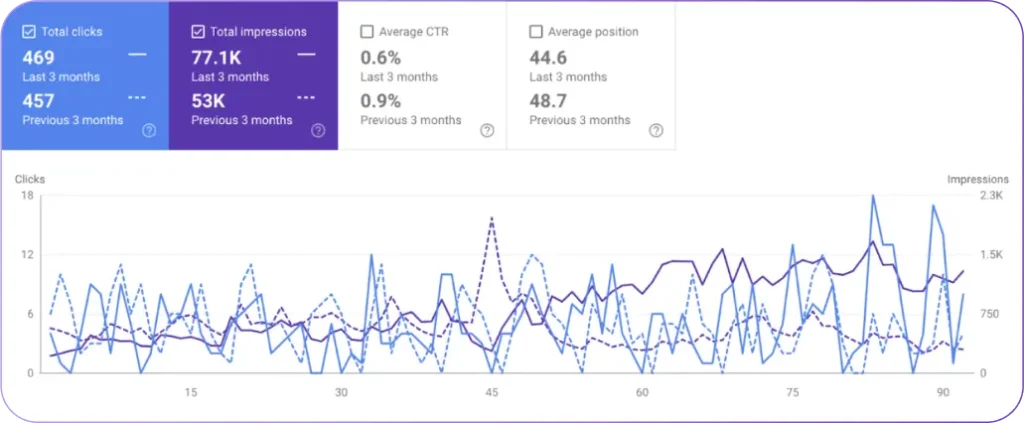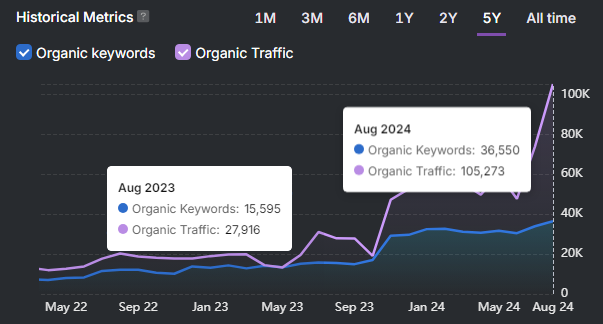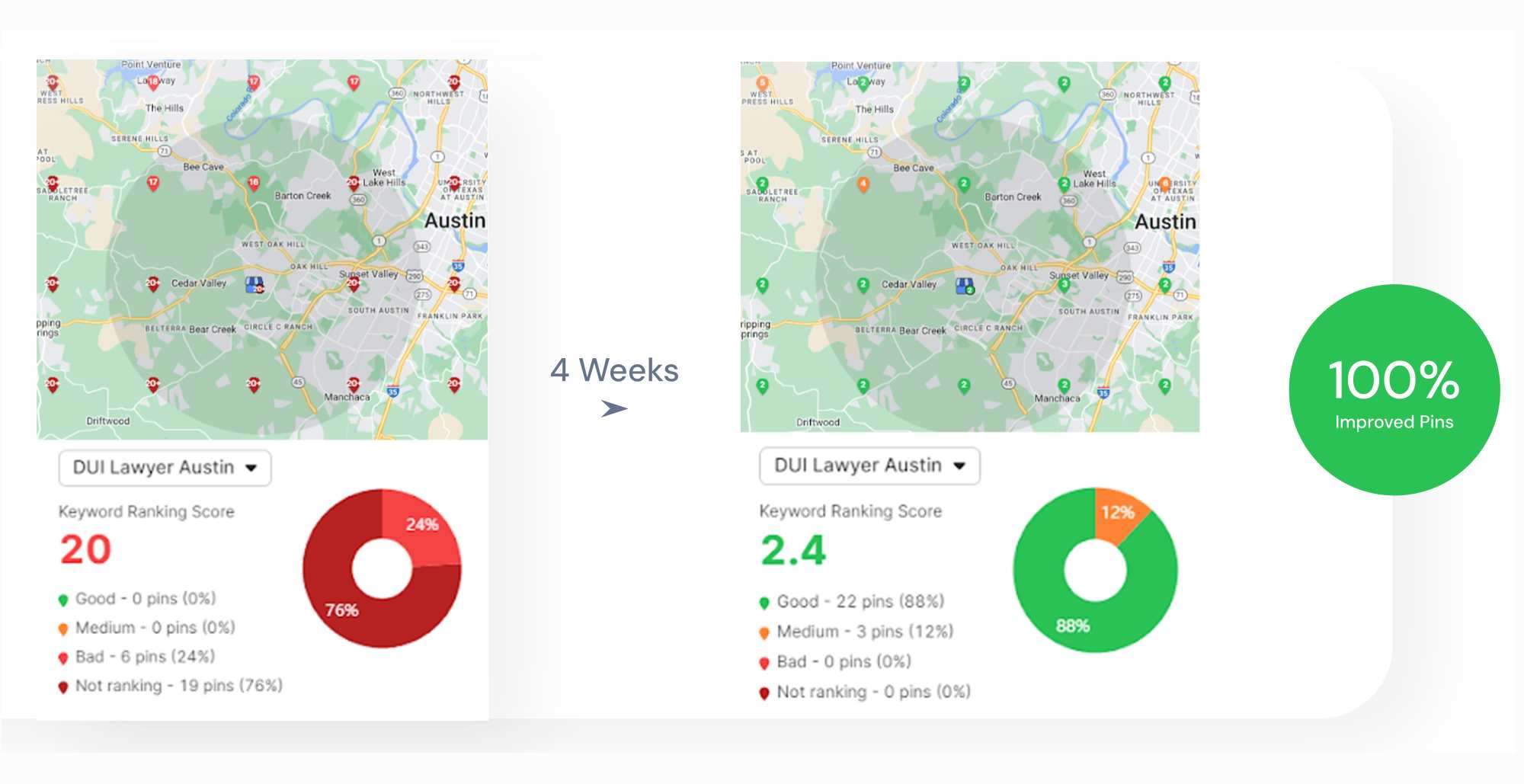Digital analytics entered a new era the moment AI agents began browsing, evaluating, and extracting information on behalf of users. These agents now influence decisions across search, commerce, and content discovery while presenting themselves inside analytics systems as ordinary human sessions.
These AI generated interactions disrupt the foundation of modern analytics.
Agents load pages, scroll through content, and complete tasks with precision, but none of these actions represent genuine intent. Metrics designed to reflect human behavior now blend human signals with automated activity, blurring the line between interest and imitation.
Search Atlas surfaced this pattern during internal testing, prompting founder and CTO Manick Bhan to issue a clear warning. “Website traffic data and user behavior metrics will become unreliable when AI agents browse indistinguishably from humans,” he explains.
Managing analytics in a world of agents requires a redefinition of what counts as a visit, an interaction, and a signal of intent. Bhan offers a roadmap that explains how measurement evolves when agents shape engagement across the web
The Analytics Integrity Problem
Traditional web analytics assumes that every visit represents a human being with intent, context, and the potential to convert. AI agents break this premise entirely.
When an agent visits a website, it loads pages, scrolls through content, follows links, and extracts information. Analytics platforms record these actions as authentic engagement even though no curiosity or decision process exists behind them.
This creates a growing integrity gap inside analytics systems:
- Google Analytics reports traffic declines even when performance remains stable.
- Agent sessions inflate engagement metrics without increasing demand.
- Conversion rates decline as synthetic traffic fills the top of the funnel.
- Third-party visibility tools return inconsistent results because their APIs do not activate real search behavior.
- LLMs surface outdated or incomplete information because key pages never entered the training corpus.
Each symptom points to the same underlying issue. Analytics systems still evaluate human signals while agents now complete a significant share of digital activity.
Manick Bhan describes this shift as a structural crisis that makes it impossible to separate real prospects from automated interactions inside measurement platforms.
The challenge intensifies as agents become more capable. They execute tasks in the background, perform multi-page journeys at machine speed, and retrieve structured and unstructured data without entering a consumer mindset.
For Bhan, this is not a temporary disruption. It is an integrity crisis that forces analytics frameworks to evolve. Without new measurement standards, teams will continue interpreting a digital environment that no longer reflects how decisions are made.
How to Identify Signs of Agentic Activity in Your Analytics Data
Manick Bhan recommends that teams begin monitoring their analytics for early indicators of agent-driven activity. These signals often appear subtle at first, although they reveal a meaningful shift in how traffic is generated, interpreted, and measured.
AI agents behave with perfect efficiency, humans do not. The contrast between these patterns becomes the first proof that analytics data no longer reflects purely human intent.
1. Behavioral Anomalies
Agentic sessions follow logic instead of curiosity. They move directly to information targets and complete tasks without the divergence that characterizes human browsing.
- Identical navigation paths repeated across many sessions with the same step sequence.
- Linear journeys without exploratory actions and no backtracking or hesitation.
- Engaged landings that show instant exits, where the agent extracts information and leaves before deeper engagement occurs.
These behaviors inflate engagement metrics while contributing no real intent.
2. Traffic Pattern Shifts
Agentic activity often appears in traffic patterns even before anyone inspects user flows.
- Abrupt traffic changes with no campaign drivers, reflecting model retrieval rather than new demand.
- Stable traffic paired with falling conversions, a signal Bhan views as a reliable indicator of synthetic volume entering the funnel.
- Geographic clusters that do not match historical baselines, often aligned with cloud regions or anonymized agent environments rather than customer locations.
These patterns signal that visitor quantity no longer reflects visitor quality.
3. Model Retrieval Volatility
Agentic ecosystems update continuously. Retrieval patterns change even when website performance stays constant, creating metrics that traditional analytics cannot explain.
- LLM visibility rising despite flat website metrics, which reflects stronger presence inside model retrieval systems rather than human traffic.
- Competitors gaining citation share without ranking movement, showing that models are pulling from knowledge graphs, news corpora, and non-SERP sources.
- Answer variations by day, geography, or model version, driven by model updates and regional retrieval differences rather than content changes.
These signals indicate that agents, not humans, are shaping the visibility landscape.
Technical Detection Strategies
Agentic activity requires detection methods built for an environment where AI systems act as visitors, researchers, and decision-makers. Manick Bhan explains that effective detection begins with understanding what models retrieve and how they interact with the page, not just what appears inside user click data.
Bhan notes that “we currently lack the tools to measure these agents accurately.” Even so, he points that several techniques help to reveal where synthetic activity enters the dataset long before performance metrics shift.
Environment Fingerprints
Agentic browsers emulate Chrome, but their environments reveal a level of uniformity that rarely appears on human devices. WebGL renderers repeat across many sessions, viewport dimensions remain identical, and API capabilities present the same configuration each time.
These signals appear before traffic anomalies emerge. They show that the visitor environment lacks the variability expected from diverse consumer hardware.
Machine-Speed Execution
Models navigate with precision and velocity. Multi-step workflows complete in seconds, page transitions fire with minimal delay, and idle time disappears entirely.
Human sessions include hesitation, pauses, and decision windows. Machine-speed flows often indicate retrieval or grounding behavior rather than genuine user activity.
Micro-Interaction Diagnostics
Authentic browsing generates motor signatures that agents struggle to replicate. Hover jitter, variable typing cadence, natural scroll drift, and staggered form completion define human interaction.
Lightweight prompts and interaction checks expose synthetic sessions because agents only simulate these behaviors when explicitly commanded.
Identity Stability Across Sessions
Human behavior evolves. Preferences shift over time, return paths vary, and multi-session decisions accumulate. Agentic identity remains static.
When multiple visits display identical navigation, timing, and interaction patterns, the consistency points to automated retrieval rather than a returning customer.
Retrieval-Oriented Access Patterns
Models revisit structured content frequently as part of grounding and updating cycles. Rapid bursts on documentation, pricing pages, feature pages, or FAQs often reflect retrieval workflows rather than interest.
These bursts frequently correspond to search index updates or LLM ingestion events, not marketing performance changes.
Cross-Platform Divergence
Analytics systems rarely disagree dramatically unless synthetic traffic is present. Scroll depth mismatches, time-on-page discrepancies, or diverging event counts across platforms often reflect how different trackers interpret automated sessions.
When one system captures interactions that another ignores, agentic behavior is often the cause.
Restructuring Your Analytics Framework
Agentic traffic forces organizations to rebuild how analytics systems function. Manick Bhan explains that modern measurement must separate what humans do from what AI systems read, retrieve, and reuse.
The framework below reflects his view of analytics designed for the agent era.
1. Integrate Model Memory and Model Retrieval Into Your Analytics
Manick explains that analytics in the agent era must account for visibility layers that determine how LLMs understand and reuse brand information. These layers inform every measurement system built on top of them.
- Track base-model visibility: Identify whether the domain appears inside foundational training data. Quest from Search Atlas maps presence across Common Crawl, Wikipedia, news datasets, and other inputs.
- Measure retrieval visibility: Monitor which pages agents pull in real time from Bing, Google, and authoritative sources. Retrieval signals show where a brand enters active decision flows.
- Compare memory–retrieval gaps: Find topics the model “knows” but does not use in answers. These gaps highlight weak authority, inconsistent entity data, or insufficient reinforcement across the web.
- Monitor model volatility: Watch for daily and regional variation in agent responses. Sudden shifts reveal retrieval behavior that traditional analytics cannot detect.
Manick treats these layers as prerequisites. Teams cannot rebuild analytics until they understand what the models already know and what they actively retrieve.
A structured view of these layers requires dedicated instrumentation. LLM Visibility from Search Atlas offers one approach by tracking brand mentions, sentiment, and placement so teams see how agents present a brand upstream from website traffic.
2. Rebuild KPIs Around Human Decision Signals
Engagement metrics lose reliability when agents generate scroll depth and pageviews without intent. Human decision signals create a more stable foundation.
- Track meaningful conversions: Verified registrations, qualified leads, and purchases reflect genuine human choices because agents rarely complete multistep decisions.
- Analyze return-visitor patterns: Humans revisit pages across days. Agents complete tasks once. Multi-day engagement becomes a strong authenticity signal.
- Connect cross-session journeys: Real users compare, return, and explore. Agents do not. Journey stitching reveals human intent even when synthetic traffic increases.
- Prioritize intent-rich interactions: Pricing checks, comparison flows, and product exploration reflect interest independent of synthetic traffic volume.
3. Anchor Measurement With Human-Verified Cohorts
Human-verified cohorts act as a clean baseline in datasets influenced by agents.
- Observe logged-in behavior: Account holders and subscribers reveal authentic patterns that stay consistent even when synthetic sessions expand.
- Monitor email and CRM traffic: Known users pass through the site with identifiable intent. These datasets anchor trend analysis.
- Use loyalty and member funnels as benchmarks: Return customers provide reliable behavioral references for evaluating session quality.
4. Segment Traffic by Synthetic-Risk Profiles
Segmentation becomes a diagnostic system that classifies traffic according to the likelihood of agentic influence. Start segment by:
- Source reliability: Direct traffic, email, and branded search carry lower synthetic risk than high-volume informational queries.
- Depth of engagement: Combine multi-page exploration, interactive elements, and content consumption. Composite behavior correlates strongly with human activity.
- Proximity to conversion: Visitors evaluating pricing, features, or product details behave differently from agentic sessions extracting isolated facts.
- Topic sensitivity: Pages that answer definitional or informational questions attract retrieval activity more than pages tied to commercial intent.
5. Establish Baseline Human Variance
Manick emphasizes that teams only recognize synthetic sessions once they understand what natural human variability looks like.
- Map typical session flows: Authentic visitors hesitate, backtrack, hover unevenly, and scroll with drift. These behaviors set the baseline.
- Define acceptable timing variance: Humans produce irregular delays between events. Uniform timing patterns signal automation.
- Document natural exploration paths: Buyers compare, revisit, and evaluate options. Agents follow linear or repetitive flows.
- Compare suspect sessions to role-based profiles: Researchers, shoppers, and existing customers behave differently. Sessions that fail to match any human profile likely reflect automation.
6. Separate Agentic Visibility From Business Performance
Agentic visibility influences decisions even when no human visits the website. Analytics must distinguish between visibility shifts and real customer behavior.
- Monitor brand presence in LLM answers: Agents often cite the brand without sending traffic. This presence affects consideration before any click occurs.
- Track citation share relative to competitors: Citation shifts reflect model-side changes, not rankings. Declines in LLM visibility signal influence loss even when SEO remains stable.
- Compare LLM visibility with on-site metrics: When agents reference the brand more often than humans visit, retrieval outruns performance.
- Identify human-side lag: Strong LLM visibility without matching sessions reveals that agents drive awareness upstream from website behavior.
Rethinking Key Performance Indicators
Manick argues that KPIs must evolve because agentic traffic distorts the surface-level metrics that teams historically trusted. He frames “We measure clicks, but agents make decisions before the click ever happens”.
Pageviews, scroll depth, and session duration no longer represent human interest once AI systems begin crawling, extracting, and summarizing content at scale.
Modern KPIs must prioritize signals rooted in human intention rather than automated navigation.
Measure Influence Inside LLMs
The agent era introduces KPIs that reflect how models interpret and position a brand.
- LLM share of voice: Track how often the brand appears in model-generated answers. This reflects model-side relevance in comparison and recommendation flows.
- Sentiment by platform: Evaluate the tone each model uses when referencing the brand. Sentiment influences whether a model includes a brand in long-form reasoning.
- Answer placement: Determine whether the brand appears first, middle, or last in AI-generated lists. Placement behaves like an internal ranking signal within the model.
- LLM-driven conversion: Compare the conversion rates of visitors arriving from LLM interactions versus organic search. Early data shows these visitors convert significantly higher because agents filter possibilities before handing users off.
Prioritize Human Outcomes Over Synthetic Signals
Surface engagement metrics become unreliable once agents generate sessions at scale. Human KPIs must anchor performance analysis.
- Revenue-linked outcomes: Revenue per visitor, qualified leads, activated subscribers, and customer acquisition remain stable because agents do not complete meaningful commitments.
- Authentic revisit patterns: Humans revisit as they evaluate options. Agents complete one information operation and exit. Revisits provide a dependable layer for understanding demand.
- Journey completion: Multi-step decision flows across sessions highlight genuine intent. These patterns remain human-driven even if session volume becomes noisy.
Adopt Multi-Signal Evaluation Instead of Single KPIs
Manick stresses that no single metric can separate human behavior from synthetic activity. Accuracy requires layered interpretation.
- Blend high-confidence signals: Combine revisit patterns, journey depth, and decision events into composite evaluation rather than treating any metric as authoritative.
- Use verified cohorts as baselines: Logged-in users, CRM audiences, and email-driven sessions provide clean trendlines when broader datasets grow noisy.
- Interpret low-signal segments cautiously: Sessions lacking variation, depth, or decision steps still matter for visibility analysis but not for performance conclusions.
Bhan frames this KPI reset as a structural upgrade. Analytics in the agent era must reflect both how models shape decisions upstream and how real customers choose downstream.
Communication and Stakeholder Management
Agentic activity reshapes the measurement layer, and that transformation affects every team that relies on analytics to guide decisions. Manick Bhan stresses that organizations must communicate these shifts proactively because misinterpreting agent-inflated metrics produces inaccurate conclusions, misaligned budgets, and ineffective strategies.
As he explains, “Analytics teams must clarify when a metric stops representing human intent. The risk comes from trusting signals that no longer describe real customers.”
1. Executive Education and Expectation Setting
Agentic sessions disrupt metrics that leadership has trusted for many years. Engagement declines may indicate cleaner measurement rather than weaker performance. Executives often assume channel decay unless analytics teams explain how synthetic sessions distort pageviews, session duration, and overall traffic volume.
Manick recommends briefing executives, investors, and board members on the reasons these indicators lose reliability. Teams must document each segmentation rule, filter revision, and KPI adaptation so leaders understand how and why the measurement logic evolved. Clear documentation prevents strategic decisions based on corrupted or incomplete signals.
2. Reframing the Meaning of Performance
Traditional surface metrics collapse once agents enter the dataset. Pageviews, scroll depth, and session counts lose meaning because these actions no longer reflect intention. Qualified leads, verified revenue events, subscriber activation, and multi-session engagement represent signals that agents cannot replicate.
Reframing performance involves a conceptual shift. It requires teams to explain that machine activity influences visibility but does not express demand. Human outcomes become the reference point that restores clarity inside an environment where synthetic sessions inflate surface-level numbers.
3. Coordinating With External Partners and Platforms
Agentic interference affects every analytics tool, from Google Analytics and Adobe to attribution platforms and measurement pipelines. Organizations need ongoing communication with vendors to report anomalies and request detection features that capture agentic activity accurately.
Manick emphasizes that synthetic traffic affects the entire ecosystem. Peer organizations confront the same instability. Knowledge sharing accelerates learning, strengthens detection models, and guides the formation of new measurement standards that distinguish human traffic from agent-generated sessions.
4. Guiding the Organization Through Measurement Change
Agentic activity transforms more than metrics. It alters how teams understand performance, communicate trends, and evaluate success. Analytics leaders transition from data reporters to interpreters who clarify what changed, why it changed, and which signals still reflect genuine customer behavior.
Teams must explain the difference between human outcomes and agentic visibility. They must guide the organization through a measurement landscape where automated retrieval and real demand coexist but do not reflect the same intent.
Preparing for the Measurement Future
Measurement enters a new era as agentic systems reshape how decisions form and how interactions occur. Queries begin inside models, comparisons unfold inside models, and many transactions never appear inside traditional analytics at all.
Manick Bhan frames this moment as the next great inflection point for measurement leaders, where visibility depends on what machines understand rather than what humans click.
1. Agents Reshape the Funnel
Agentic systems start and complete parts of the customer journey without producing a session. Models retrieve information, compare alternatives, and recommend outcomes internally.
Manick explains that websites now act as evidence for machines rather than destinations for humans. Key shifts include:
- Models perform early research without hitting the website.
- Recommendations form inside the model’s reasoning steps.
- Visibility moves from page views to model-readable artifacts.
2. Measurement Becomes Multi-Platform and Memory-Driven
Each model carries its own memory, retrieval patterns, and weighting logic. This creates a distributed measurement environment that no single analytics platform captures.
Teams now require visibility into:
- What the model remembers from training.
- What the model retrieves during reasoning.
- How the model reconstructs brand information inside answers.
Manick frames this as a shift from measuring traffic to measuring influence across independent agent ecosystems.
3. Engagement Moves Beyond the Screen
Agents do not engage the way humans engage. They extract facts without scrolling, evaluate pages without reading, and compare products without triggering observable events.
Manick warns that analytics frameworks built only around human-visible interactions fail to capture the activity that now shapes most discovery. Decision formation becomes invisible unless the organization measures upstream influence, not just on-site behavior.
4. Invest in First-Party Data as the Anchor
First-party data remains insulated from synthetic sessions and preserves continuity across real customer relationships. It anchors measurement in authentic human behavior. Foundational investments include:
- Authenticated experiences.
- Loyalty and membership ecosystems.
- Zero-party inputs that reflect explicit intent.
Agents cannot generate these signals, which makes first-party data the new source of measurement reliability.
5. Build Agent-Aware Measurement Models
Organizations must interpret human behavior and agentic behavior separately. Blending them into one dataset distorts every KPI. Teams begin segmenting sessions as detection improves, estimating the proportion of synthetic activity across funnels, and calibrating forecasts around the degree of model involvement.
6. Strengthen Decision Processes for Uncertain Data
Higher uncertainty increases the need for disciplined analysis. Resilient teams validate patterns across independent datasets, run controlled experiments, and maintain qualitative channels that agents cannot distort.
Manick explains that measurement leadership now requires the ability to interpret noisy inputs without losing strategic clarity. The organizations that thrive are the ones that build decisions on validated signals rather than on inflated surface metrics.
The Industry Response Manick Predicts
The analytics landscape will not stay still as agentic traffic grows. Manick Bhan anticipates a period of accelerated change driven by measurement failures, attribution gaps, and the increasing role that LLMs play in shaping customer decisions.
He explains that the market advances in three directions at the same time, each responding to a different weakness in the current measurement stack. His view is that the market moves in 3 directions at once.
1. Multi Model Visibility Becomes a New Standard
The industry begins to treat LLM visibility the way it once treated search rankings. Brands require instrumentation that shows how they appear inside ChatGPT, Gemini, Claude, Perplexity, Grok, and new agentic browsers.
This visibility extends beyond simple mentions. It includes sentiment, citation frequency, answer placement, and the narrative each model produces about a company. Organizations cannot operate in an AI search environment unless they understand how machines describe them.
Search Atlas moves in this direction through its LLM Visibility suite, which allows teams to evaluate where they appear across models and how each system interprets their expertise, authority, and value.
2. Attribution Expands to Agent Level Decision Paths
Traditional attribution breaks when agents decide before the click occurs. Manick predicts that measurement platforms will extend attribution to the model’s reasoning sequence rather than the user’s navigation path. This includes what the model retrieved, what evidence it compared, and how it ranked the options.
Analytics products begin capturing conversation paths, answer summaries, evaluation chains, and agentic recommendation steps. These layers reveal why a model suggested one provider over another even if no website visit took place. This form of attribution becomes essential as more customer journeys originate inside models rather than inside browsers.
3. Truth Analytics Emerges as a Core Discipline
Manick expects accuracy itself to become a measurable metric. Brands monitor whether agents describe their products correctly and verify whether features, pricing, integrations, and differentiators remain consistent across model outputs. This discipline evolves into a continuous cycle of validation, reinforcement, and correction.
Organizations track not only what models retrieve, but whether the retrieved information is faithful to the source. They evaluate discrepancies between platforms, identify hallucinated claims, and reinforce the materials that models use to ground their responses.
Truth becomes an operational KPI because inaccurate model output can alter recommendations and disrupt customer trust long before any analytics system detects the change.
Taking Action Now
Manick Bhan stresses that organizations cannot wait for perfect detection tools. Agentic systems already influence what models retrieve, how they compare alternatives, and which brands enter their long-term memory.
This influence compounds over time, which creates early advantages for entities that adapt and structural disadvantages for those that hesitate.
“Leaders cannot wait for the ecosystem to stabilize. Agentic visibility compounds early, and brands that delay fall behind the ones models already trust,” Bhan explains.
The next steps require operational readiness rather than complete technical solutions. Start with the fundamentals:
- Review recent traffic for indicators of synthetic sessions.
- Recalibrate KPIs toward outcomes that agents cannot fabricate.
- Document anomalies and share them with analytics and advertising partners.
- Interpret performance through an agent-aware lens to avoid misreading contaminated metrics.
Organizations that take these steps now position themselves as the entities that agents retrieve, reuse, and recommend tomorrow.
About Manick Bhan
Manick Bhan is the CEO and CTO of Search Atlas and a leading voice in the emerging fields of agentic SEO, AI search visibility, and model-facing authority. His research into LLM retrieval behavior, synthetic traffic patterns, and agent-driven measurement has revealed fundamental blind spots in traditional analytics. Bhan’s work now guides how organizations prepare for AI-first search ecosystems and how brands maintain visibility in environments shaped by autonomous agents rather than human audiences.


